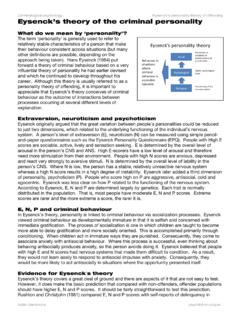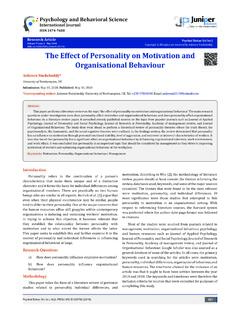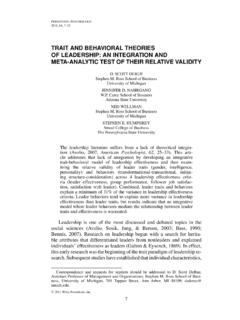Transcription of Get Excited: Reappraising Pre-Performance Anxiety as ...
1 Journal of Experimental Psychology: General 2013 American Psychological Association 2014, Vol. 143, No. 3, 1144 1158 0096-3445/14/$ DOI: Get Excited: Reappraising Pre-Performance Anxiety as Excitement Alison Wood Brooks Harvard Business School Individuals often feel anxious in anticipation of tasks such as speaking in public or meeting with a boss. I find that an overwhelming majority of people believe trying to calm down is the best way to cope with Pre-Performance Anxiety . However, across several studies involving karaoke singing, public speaking, and math performance, I investigate an alternative strategy: Reappraising Anxiety as excitement. Com- pared with those who attempt to calm down, individuals who reappraise their anxious arousal as excitement feel more excited and perform better. Individuals can reappraise Anxiety as excitement using minimal strategies such as self-talk ( , saying I am excited out loud) or simple messages ( , get excited ), which lead them to feel more excited, adopt an opportunity mind-set (as opposed to a threat mind-set), and improve their subsequent performance.
2 These findings suggest the importance of arousal congruency during the emotional reappraisal process. Keywords: Anxiety , excitement, reappraisal, emotion regulation, arousal congruency During World War II, England's Ministry of Information com- Across several experimental studies, I test an alternative strat- missioned a public safety slogan: Keep Calm and Carry On. egy: Reappraising Pre-Performance Anxiety as excitement. Whereas Sixty years later, the slogan resurfaced and went viral, with hun- Anxiety is a negative, aversive emotion that harms performance, dreds of thousands of retail products and derivative slogans dom- excitement is a positive, pleasant emotion that can improve per- inating Internet marketplaces by 2007. In an attempt to explain the formance (Cropanzano, James, & Konovsky, 1993; Jamieson, popularity of the slogan, one New York Times writer conjectured Mendes, Blackstock, & Schmader, 2010).
3 Anxiety and excitement that it resonated all over the world (Walker, 2009). In the current have divergent effects on performance, but the experience of these article, I investigate the pervasiveness of this conventional wisdom two emotions is quite similar. They are both felt in anticipation of and test its effectiveness compared with an alternative strategy: events and are characterized by high arousal. Unlike anxious Reappraising Anxiety as excitement. versus calm feelings, which differ in high versus low arousal, Individuals feel anxious often, especially prior to important Anxiety and excitement are arousal congruent, and minimal inter- tasks like speaking publicly or meeting with a boss. When felt ventions may be sufficient to produce feelings of excitement. This immediately before or during a task, Anxiety drains working mem- notion builds on seminal work on the misattribution of arousal ory capacity, decreases self-confidence, and harms performance ( , Schacter & Singer, 1962).
4 We know that when a source of ( eysenck , 1992). Anticipating the negative consequences of feel- arousal is ambiguous, people often misunderstand the true source ing anxious, many individuals attempt to down-regulate Anxiety by of their arousal. In contrast, I focus on situations in which the trying to calm down. But decreasing anxious feelings is difficult source of arousal is obvious, such as asking people to sing in front because high arousal is automatic, and suppressing or hiding of strangers or to complete a difficult math task. After increasing Anxiety is often ineffective ( , Hofmann, Heering, Sawyer, & anxious arousal, I suggest a minimal, deliberate intervention to Asnaani, 2009). reappraise the arousal as a positively valenced emotion, excite- ment. My research makes several theoretical contributions. First, it This article was published Online First December 23, 2013.
5 Dives deeply into an important omission in the emotion regulation This study was supported by the Operations and Information Manage- literature. Previous work has not considered the role of arousal ment Department, the Wharton Behavioral Lab, and the Wharton Risk Center Russell Ackoff Fellowship. I am grateful for feedback from Mau- congruency during emotional reappraisal, and very few empirical rice Schweitzer, Katy Milkman, Adam Grant, Adam Galinsky, Phil Tet- studies have directly compared different substrategies of reap- lock, Francesca Gino, Sigal Barsade, and Derek Brooks and for comments praisal (Shiota & Levenson, 2012). The current research addresses from the Wharton Decision Processes Colloquium, NYU Management these omissions and answers Han, Lerner, and Keltner's (2007). Department, London Business School Organisational Behavior Depart- call to study the action tendencies related to both high arousal and ment, MIT Sloan Management Department, and Harvard Business School discrete positive emotions.
6 I expect that Reappraising one high- NOM unit. Many thanks to Aye Thu, Kathleen Ho, Tim Flank, Peter Hage, arousal emotion ( Anxiety ) as another high-arousal emotion (excite- Chris Chan, Josh Carrington, Attilio Dimartino, Kaity Moore, and Ethan ment) is easier and more effective than trying to shift from high Ludwin-Peery for their help with data collection and coding. All errors in arousal ( Anxiety ) to low arousal (calmness). the article are my own. Correspondence concerning this article should be addressed to Alison Second, this research complements a body of work about mis- Wood Brooks, Harvard Business School, Negotiation, Organizations & representing emotions. Previous work suggests that inauthentic Markets Unit, 463 Baker Library, Boston, MA 02163. E-mail: awbrooks@ emotional displays differ from authentic expressions and that deliberate attempts to express inauthentic emotions are an act of 1144.
7 GET EXCITED 1145. emotional labor that can be physically and psychologically costly that demand stamina or persistence ( , eysenck , Derakshan, ( , C t , 2005; Ekman, 1992; Grandey, 2000, 2003; Gross & Santos, & Calvo, 2007). Levenson, 1993; Morris & Feldman, 1996). In contrast, pre- However, feeling very anxious shortly before or during a task performance Anxiety and excitement may serve as a counterexam- tends to harm cognition and performance, especially for nonex- ple to these findings. By misrepresenting anxious arousal as perts. Anxiety drains working memory and limits information excitement, I expect a genuine experience of excitement to follow. processing. Anxious individuals waste working memory on pro- Third, my research points to the labile nature that can exist cesses like worrying and ruminating instead of focusing on the task between two seemingly discrete and disparate emotions.
8 By high- at hand (see eysenck , 1992, for a review). lighting the fine line between emotions like Anxiety and excite- Anxiety also negatively influences motivational mechanisms ment, we can better understand how individuals experience two such as risk aversion and self-confidence (Han et al., 2007; Rag- emotions simultaneously ( , mixed emotions or emotional am- hunathan & Pham, 1999). Recent work suggests that state Anxiety bivalence; Ersner-Hershfield, Mikels, Sullivan, & Carstensen, lowers self-efficacy, the belief that one can succeed on a specific 2008; Larsen & McGraw, 2011; Rothman, 2011) or shift from one task (see Bandura, 1997, for a review). Low self-confidence, in emotional state to another ( , emotional transitions; Filipowicz, turn, profoundly influences decision making and behavior. For Barsade, & Melwani, 2011). example, anxious negotiators make low first offers, exit early, and earn less profit than neutral state negotiators.
9 These effects are mediated by low negotiator self-efficacy (Brooks & Schweitzer, Anxiety 2011). Similarly, anxious individuals seek out and rely more heavily on advice, even when the advice is obviously bad, because Anxiety is a specific emotion characterized by high arousal, they do not feel confident in their own ability to make good negative valence, uncertainty, and a low sense of control (Gray, judgments (Gino et al., 2012). 1991; Raghunathan & Pham, 1999; C. Smith & Ellsworth, 1985). Consistent with prior research, I conceptualize Anxiety as a state of distress and/or physiological arousal in reaction to stimuli Reappraising Anxiety as Calmness including novel situations and the potential for undesirable out- Though Anxiety tends to harm performance, Pre-Performance comes (Brooks & Schweitzer, 2011, p. 44). Threats that trigger Anxiety can be managed.
10 Emotion regulation scholars have com- Anxiety can be quite minimal, such as the mere proximity of pared the effectiveness of different emotion regulation strategies another individual or a fleeting unpleasant memory. Or they can be for managing state Anxiety . General consensus has emerged that significant, such as the threat of failure, embarrassment, or phys- reappraisal is the most effective strategy for mitigating the expe- ical harm (Tallis, eysenck , & Mathews, 1992). rience of state Anxiety . Reappraisal has been defined as a form of The threats that elicit Anxiety change over one's life span. For cognitive change that involves construing an emotion-eliciting example, Anxiety is triggered by anticipated separation from a situation in a way that changes its emotional impact (Gross &. primary caregiver at 12 months (Carlson & Sroufe, 1995), mon- John, 2003, p.)














